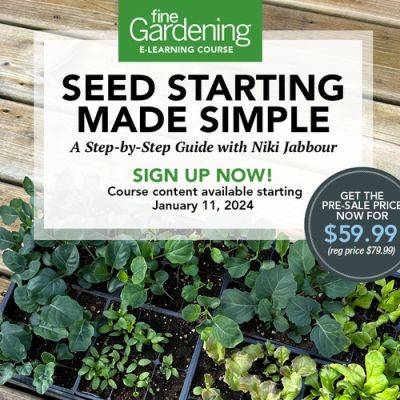Starting plants from seed opens a world of possibilities to gardeners of all skill levels. Many vegetables, annual flowers, and even perennial plants can be started from seed using a few basic supplies and easy-to-master techniques. This can be an economical way to fill garden space and enjoy a much wider variety of plants than you could find in any nursery. In this course, horticulturist Niki Jabbour will share tips and tricks from her decades of starting seeds. After covering the basics, she will delve into more advanced topics such as timing and stratification. Participants will learn about which tools and supplies the pros recommend to make seed-starting easier, and how to set up a simple DIY lighting system. Build your gardening skills and enjoy the satisfying feeling of growing plants from scratch with this fun, fast-paced course.
We Bought a Home with a Sterile Suburban Yard. Our Journey To Bring Life Back is Just Beginning
06.10.2023 - 15:09 / modernfarmer.com
My husband and I bought our first home in a small West Virginia town in January 2023. The bright green dwelling sits in the middle of a dead-end street where retirees claim most homes as the original dwellers. From 1978 until now, our house had only one homeowner. So, for the past 45 years, the yard has been a neatly mowed lawn with a single tulip tree.
We had grand plans to install a curated pollinator garden in the front and a vegetable garden with a managed meadow in the back. Since I started my career in the environmental sector, I have preached to anyone who looked in my direction about planting native plants. I boasted about how indigenous flowers would aid pollinators that suffer from habitat loss, store greenhouse gasses and create a buffer against drought and heavy rains. I knew that the US’s 40 million acres of lawns contribute to greenhouse gas emissions through consistent mowing and drink up to nine billion gallons of water daily. If I kept the non-native lawn, not only would I be going against my convictions, I would have to step down from my soapbox and admit to being a fraud.
However, practicing is different from preaching. When we started the quest to revitalize our property, we did not know the extent that our soil was compacted and how climate change was affecting our new town.
When I was younger, I helped my mother with her vegetable garden. I found joy in the feeling of dirt in the creases of my hands and the flavors of homegrown produce that embedded in my memories. We had to fight clay each year, but we still produced a hefty bounty. I wanted to continue the tradition at my first house, and I had no worries when I noticed clay on my new property. However, my childhood garden bordered a

Carol Klein's Favourite Plants for Winter Containers
There’s nothing like a beautifully planted pot to bring life to the garden in late winter. Planted in early February and positioned near the back door, colourful containers give us something to focus on and appreciate, whatever the weather.

A Comprehensive Blueprint for Life on Mars
Header image: An artist’s depiction of a fictional Mars colony, with solar arrays and underground greenhouses. Image credit: NASA

When to Cut Back Ornamental Grasses: A Complete How-to Guide
Ornamental grasses are essential garden plants for their naturalistic beauty, year-round interest, fine textures, drought tolerance, and resistance to insects and pests. When planted in the right site, they’re also low-care perennials that require little more than an annual haircut. The timing of when to cut back ornamental grasses is important to ensure they’re trimmed before the new growth begins, but not so early that you forfeit winter interest. Keep reading to learn everything you need to know about when to cut back ornamental grasses.

Channel the Hamptons with These Coastal Home Decor Tips From the Pros
Joyelle West

Transform Unused Spaces in Your Home With These 8 Designer-Approved Ideas
If you’ve found yourself stumped on how to style that lonely corner in your dining room or make use of the empty space under your stairs, you’re not alone. In fact, interior designers have a whole slew of tricks for dealing with these spaces that are not living up to their potential.

Celebrating Hispanic Heritage Month with Healthy Traditions
Hispanic Heritage Month is a celebration of the rich and diverse culture and history of the Hispanic and Latino countries and communities. It runs from September 15th to October 15th and holds a special significance as many Central and South American countries celebrate their independence days within this timeframe, adding to the pride each country has for its unique history. In this celebration of culture, we cannot overlook the significance of traditional Hispanic foods. These dishes, with their unique blend of influences, reflect the heart and soul of Hispanic and Latino heritage. From mole in Mexico to arepas in Colombia, these culinary traditions tell a story of diversity and flavor.

Transform your home interior design with acoustic panels
Collaborative post

Easily Increase Your Home's Value With These Lighting Upgrades
When the housing market slows down, it's common to look for anything to make your home outshine the competition. We asked some experts to share their best tips for instantly increasing your home's value and their answers may shock you with how easy it is.

25 Trees With Smooth Gray Bark
Trees With Smooth Gray Bark—these fascinating specimens promise a blend of aesthetic charm and ecological value. Read on to uncover the top species that you must make a part of your garden!

How to Mulch with Straw: A Step-by-Step Guide
Are you wondering how to mulch with straw? Using an organic mulch in the garden is an easy way to reduce weeds and how often you need to water. Plus, straw is inexpensive, widely available, and enriches the soil as it breaks down. However it’s important to make sure you’re using the right amount of straw and applying it at the best time. Below I cover all the basics of how to mulch with straw and offer tips to ensure your success. Read on to learn how to put straw mulch to work in your garden.

Bring Your Creative Projects To Life With Craftcore
During the height of the pandemic, many of us had a bit (OK, maybe a lot) of extra time on our hands, and to cope, a lot of us picked up a few new hobbies—some in the form of crafts. While crafts and handiwork are excellent ways to keep ourselves busy during downtime, they're also wonderful ways to channel our creativity into something beautiful, also worthy of displaying in our homes.
